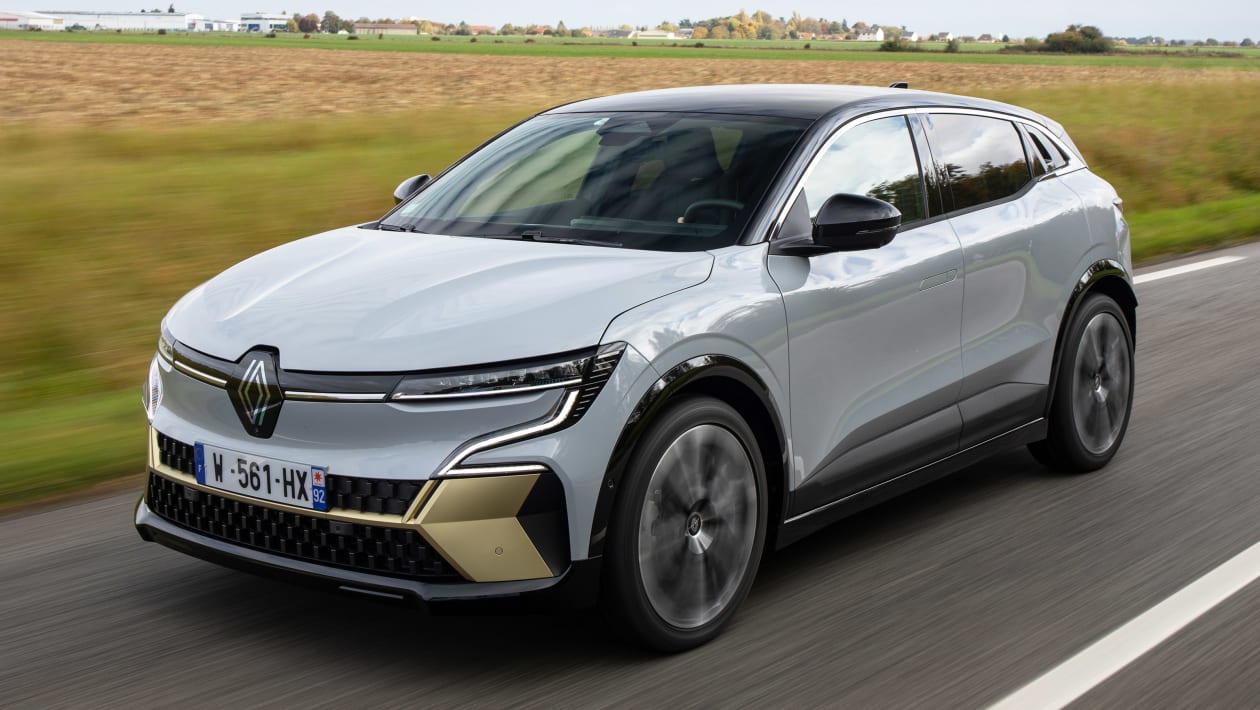As a gasoline or diesel powered family hatchback, the Renault Megane never sold as well as the Ford Focus or the Volkswagen Golf. Renault has completely changed the formula for the new model; The Megane is now a trendy SUV powered exclusively by electric motors, competing with the Volkswagen ID.3 and Nissan Leaf, as well as the Citroen e-C4 and Kia e-Niro.
The Renault Megane E-Tech Electric shares the same focus on style as previous generations of the Megane. Slim LED headlights and a modeled bonnet give the front end an unmistakable appearance, while at the rear there is an almost continuous light bar, flush door handles, golden details and a sloping roof. It looks conspicuous, but due to the angle of the contrasting roof, the rear window is very narrow.
The interior is also an eye-catcher with two 12-inch displays, but more traditional and user-friendly than a Volkswagen ID.3. A new Google-based system runs on the portrait infotainment screen with an excellent voice control system, while physical buttons and knobs for air conditioning have been retained. There are a few hard plastics here and there, but overall the interior feels higher quality than old Renaults, and lower trim levels have a lot of recycled materials.
However, the news isn’t great if you’re destined to sit in one of the back seats. The new Megane is a bit more spacious than the old one, but it doesn’t convey the same sense of space that we’re used to from electric cars. The Megane’s arch-rival, the ID.3, feels roomier for those in the back seats. The 440-liter trunk is more impressive, although loading heavy items can be difficult due to the lack of a false floor.
Prices and specs have yet to be announced, but with Volkswagen’s benchmark this clear, we would expect the prices to be similar. Given that the outgoing Megane hatchback is now only available as a plug-in hybrid starting at nearly £ 30,000, the new electric Megane may look like value for money.
A range of nearly 300 miles should be sufficient for the majority of buyers
Renault has focused on making the new Megane as light as possible, using a lot of aluminum in its construction. While the battery ensures that the car is not as light as a feather, the 1,624 kg curb weight of our test car is almost 200 kg less than an equivalent ID.3, which improves efficiency. Renault strives for exact range figures rather than impressive but unrealistic ones.
There are two battery sizes available: 40kWh and 60kWh. These offer up to 186 or 292 miles when fully charged. Thanks to fast charging with up to 130 kW, a charge of 10 to 80% can be achieved in half an hour. Depending on your electricity tariff, a full charge at home should cost less than € 10. There is no VED (road tax) to be paid and company car drivers pay a minimal amount of benefits in kind.
The Renault Megane E-Tech electric SUV comes with a five-year / 100,000 mile warranty with no mileage restrictions for the first two years. That is more generous than the aftersales cover of the ID.3. We also expect an eight year / 100,000 mile battery warranty like the Renault ZOE, which will cover you if the battery capacity falls below 70% within these limits.
Powerful acceleration and quick steering enhance the Megane’s driving experience
Renault’s boss said the Megane felt like an electric hot hatch while driving. We wouldn’t go that far, but the new Megane is decent to drive. The late pre-production model we drove came off the production line very quickly and offered quick acceleration at any speed. The electric motor has an output of 217 hp and a time from 0 to 100 km / h of under 7.5 seconds – and it feels faster.
Since the Megane E-Tech is quite light for an electric car and most of the weight in the car is light, there is almost no body tilt. Its steering is pleasantly quick, albeit numb, and the rear suspension ensures a pleasant driving experience. Switching between the Eco, Comfort, Sport and Individual driving modes changes the driving experience and you can choose the braking regeneration you want, but you can do it not just with a pedal as with an ID.3 or a. drive sheet.
High-tech and reasonably high-quality, the interior of the Renault Megane is overall impressive
Open the door with the fold-out door handle and you will be greeted by a state-of-the-art interior. As is common today, there are two screens for the driver display and the media / navigation functions, but the latter is like a phone in portrait mode. The slight inclination towards the driver makes you feel like you are in the cockpit of a sports car. Renault also claims that the materials used in lower versions are recycled, while our top-of-the-line test car had wood paneling on the door panels and synthetic leather upholstery.
The infotainment touchscreen uses a new system operated by Google so you can navigate Google Maps and say commands with “Hey Google”. The Maps app includes public chargers nearby, while the voice control system is the best we’ve ever come across, so you can change the temperature and easily check the weather forecast. Apple CarPlay is also standard. A digital rearview mirror is also available to overcome the poor visibility from the flat rear window.
Nowadays it is tempting to put all the controls in the touchscreen, but Renault has kept physical climate controls that are easier to use while driving. This and the materials used contribute to the fact that the Megane feels more noble inside than the ID.3. There are some cheaper materials on display, but overall the quality is very good.
The Megane’s trunk is good, but the space in the back seats is less
You would expect that the combination of an SUV body style and a dedicated electric motor platform means the Megane E-Tech Electric is very roomy, but this is one of the few areas where we think the Renault could be improved. The space in the back seats is likely on par with the old car, but the front seats feel a bit too cramped, which could be within easy reach of children in car seats. Legroom is fine unless the front seats are in a low position, but at least there’s a level floor so that whoever sits in the center seat doesn’t have to spread their legs on either side of a transmission tunnel. Electric cars tend to feel much more spacious than their gasoline rivals; the much-mentioned ID.3 has significantly more space in the rear than, for example, the Golf, but that is not the case with the Megane.
The trunk is large and deep with 440 liters. The Megane is front-wheel drive, so it doesn’t have a bulky engine on the rear axle. That means it could be quite difficult to lift heavy or bulky items in and out of, although we’ve been told that a double floor will be optional when the car goes on sale in the fall of 2022.
Renault has a lot of experience with electric cars
While other manufacturers only dip their toes in the water when it comes to electric cars, Renault has already got on board. The Renault ZOE was launched almost a decade ago and the French brand has improved its drivetrains and durability over time. The basis of the Megane E-Tech is a new platform, but it was jointly developed with Nissan, which has also sold an electric car for the past decade. The Megane will share its ‘CMF-EV’ architecture with the upcoming Nissan Ariya.
Renault achieved a top 20 position in our driver satisfaction survey in 2021. The brand’s cars were recognized for their infotainment systems, driving behavior and handling, build quality, styling, and value, with only maintenance costs getting a lower rating. However, the Megane should be cheaper to maintain than a gasoline or diesel car.
A five-star Euro NCAP rating is pretty much standard for an electric family car. We’ll have to wait and see how it fares in the security tests; the newest Renault Captur, Renault Clio and Renault Arkana all received five stars. Level 2 semi-autonomous driving will be available, combining Lane Keeping Assist with adaptive cruise control.

